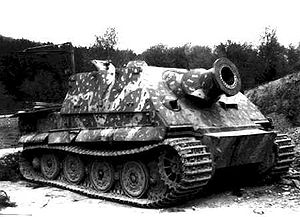Sturmtiger
| Sturmmörserwagen 606/4 mit 38 cm RW 61 | |
|---|---|

Captured Sturmtiger, April 1945
|
|
| Type | Heavy assault gun |
| Place of origin | Nazi Germany |
| Service history | |
| In service | August 1944 - 1945 |
| Wars | World War II |
| Production history | |
| Designer | Alkett |
| Designed | 1943–1944 |
| Manufacturer | Alkett |
| Produced | October 1943 – January 1945 |
| No. built | 19 (1 prototype and 18 production) |
| Specifications | |
| Weight | 68 tonnes (75 short tons; 67 long tons) |
| Length | 6.28 m (20 ft 7 in) |
| Width | 3.57 m (11 ft 9 in) |
| Height | 2.85 m (9 ft 4 in) |
| Crew | 5 driver machine gunner / radio operator loader 2nd loader commander / gunner |
|
|
|
| Armor | max. 150 mm (superstructure front, at 47° from vertical) min. 62 mm |
|
Main
armament |
380 mm RW 61 rocket launcher L/5.4 (14 rounds) |
|
Secondary
armament |
100 mm grenade launcher (using SMi 35 leaping mines) 7.92 mm (0.312 in) MG 34 machine gun |
| Engine | V-12, water-cooled Maybach HL230P45 engine 700 PS (690 hp, 515 kW) |
| Power/weight | 10.77 PS/tonne |
| Suspension | torsion-bar |
|
Operational
range |
120 km (75 mi) |
| Speed | 40 km/h (25 mph) |
Sturmtiger (German: "Assault Tiger") was a World War II German assault gun built on the Tiger I chassis and armed with a 380mm rocket-propelled round. The official German designation was Sturmmörserwagen 606/4 mit 38 cm RW 61. Its primary task was to provide heavy fire support for infantry units fighting in urban areas. The few vehicles produced fought in the Warsaw Uprising, the Battle of the Bulge and the Battle of the Reichswald. The fighting vehicle is also known under a large number of informal names, among which the Sturmtiger became the most popular.
The idea for a heavy infantry support vehicle capable of demolishing heavily defended buildings or fortified areas with a single shot came out of the experiences of the heavy urban fighting in the Battle of Stalingrad in 1942. At the time, the Wehrmacht had only the Sturm-Infanteriegeschütz 33B available for destroying buildings, a Sturmgeschütz III variant armed with a 15 cm sIG 33 heavy infantry gun. Twelve of them were lost in the fighting at Stalingrad. Its successor, the Sturmpanzer IV, also known as Brummbär, was in production from early 1943. This was essentially an improved version of the earlier design, mounting the same gun on the Panzer IV chassis with greatly improved armour protection.
While greatly improved compared to the earlier models, by this time infantry anti-tank weapons were improving dramatically, and the Wehrmacht still saw a need for a similar, but heavier armoured and armed vehicle. Therefore, a decision was made to create a new vehicle based on the Tiger tank and arm it with a 210 mm howitzer. However, this weapon turned out not to be available at the time and was therefore replaced by a 380 mm rocket launcher, which was adapted from a Kriegsmarine depth charge launcher.
...
Wikipedia
